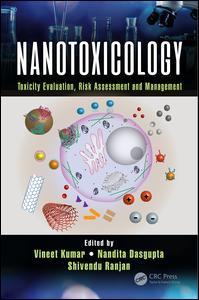Nanotoxicology Toxicity Evaluation, Risk Assessment and Management
Coordonnateurs : Kumar Vineet, Dasgupta Nandita, Ranjan Shivendu

As the application of nanotechnology in the myriad disciplines of science and engineering--from agriculture, pharmaceuticals, material science, and biotechnology to sensors, electronics, and mechanical and electrical engineering--brings benefits it also can produce serious threats to human health and the environment that must be evaluated.
The unique properties of nanomaterials make them different from their bulk counterparts. In addition to such unique properties, the nanometric size of nanomaterials can invite some detrimental effects on the health and well-being of living organisms and the environment. Thus, it is important to distinguish nanomaterials with such ill effects from nanomaterials with no or minimum toxicity.
Nanotoxicology: Toxicity Evaluation, Risk Assessment and Management covers issues such as the basic principles of nanotoxicity, methods used for nanotoxicity evaluation, risk assessment and its management for nanomaterial toxicity with a focus on current trends, limitations, challenges, and future directions of nanotoxicity evaluation.
Various experts from different countries discuss these issues in detail in this book. This will be helpful to researchers, educators, and students who are interested in research opportunities for avoiding the environmental and health hazards of nanomaterials. This book will also be useful for industrial practitioners, policy makers, and other professionals in the fields of toxicology, medicine, pharmacology, food, drugs, and other regulatory sciences.
Introduction to Nanotoxicity: Historical Overview of Nanotechnology in Context to Nanotoxicity. Nanomaterials and Environment. Safety Aspects of Nanomaterials Used in Foods, Drugs, Cosmetics and Other Iindustries. Ethics in Nanotechnology and Society Perception. Factors Affecting Toxicity of Nanomaterials: Impact of Physiochemical Properties and Surface Chemistry of Nanomaterials on Toxicity. Effect of Route of Nanomaterial Exposure on Toxicity of Nanomaterials. Effect of Test Dose on the Nanomaterials Toxicity. Influence of Test Model Selection on Nanotoxicity Evaluation. Nanotoxicity to Environment and Living Organism: Interaction of Nanomaterials with Biological Matrices. Toxic Effect of Nanomaterials to Environment. Interaction of Nanomaterials with Animal Cell Lines: in vitro Studies. Nanotoxicity Evaluation Using Experimental Animals: in vivo Studies. Influence of Nanomaterials on Human Health. Toxic Effect of Nanomaterials to Plants and Beneficial Soil Bacteria. Methods of Nanotoxicity Evaluation: Methods for in vitro and in vivo Animal Nanotoxicity Evaluation. In vitro and in vivo Nanotoxicity Evaluation in Plants. Nanotoxicological Evaluation in Water and Marine Organisms. Pharmacokinetics Approach for Nanotoxicity Evaluation. Genomic Approach in Nanotoxicity Evaluation. In silico Methods for Nanotoxicity Evaluation. Sensors for Toxicity Evaluation of Nanomaterials. Regulatory Guidelines and Future Risk Assessment Strategies in Nanotoxicity: Guidelines and Protocols for Nanotoxicity Evaluation. Regulations for Safety Assessment of Nanomaterials. Minimizing Nanotoxicity with Green Chemistry. Improving Nanotoxicity Evaluation Via the Use of miRNA, siRNA and Stem Cell Studies. Challenges, Recommendations and Strategies for Nanotoxicity Evaluation and its Management.
Vineet Kumar is currently working as Dr DSK postdoctoral fellow in the Department of Chemistry, Panjab University Chandigarh, UT India. He has worked in different areas of biotechnology and nanotechnology in various institutes and universities namely, CSIR-Institute of Microbial Technology, Chandigarh, U.T., India, CSIR-Institute of Himalayan Bioresource Technology, Palampur, H.P. India and Himachal Pradesh University, Shimla, H.P. India.
His areas of interest include green synthesis of nanoparticles, nanotoxicity testing of nanoparticles and application of nanoparticles in drug delivery, food technology, sensing, dye degradation and catalysis. He has published many research articles in these areas featuring in peer-reviewed journals.
Nandita Dasgupta is currently serving as Research Associate at VIT University, Vellore, Tamil Nadu, India. She has exposure of research institutes and industries including CSIR-Central Food Technological Research Institute, Mysore, India and Uttar Pradesh Drugs and Pharmaceutical Co. Ltd., Lucknow, India. Her areas of interest include toxicological analysis, natural products technology, nanobiotechnology and agri-food technology. She has published many scientific articles in international peer reviewed journals and also serving as editorial board member and referee for reputed international peer reviewed journals. She has received Elsevier Certificate for “Outstanding Contribution” in Reviewing from Elsevier, The Netherlands. She has also been nominated for Elsevier advisory panel for Elsevier, The Netherlands. She was the Guest Editor in Journal of Chemistry for the special issue entitled “Food Nanotechnology Opportunities and Challenges”.
Shivendu Ranjan is currently working as DBT-Research Fellow, Department of Biotechnology, Ministry of Science and Technology, Govt of India at VIT University, Vellore, Tamil Nadu, India. He is also serving for a non-government or
Date de parution : 03-2018
15.6x23.4 cm
Disponible chez l'éditeur (délai d'approvisionnement : 15 jours).
Prix indicatif 244,87 €
Ajouter au panierThèmes de Nanotoxicology :
Mots-clés :
Alkaline Comet Assay; nanobiotechnology; LDH Assay; nanoparticles; Graphene Quantum Dots; nanomaterials; Cerium Oxide Nanoparticles; risk assessment; DNA Damage; regulatory issues; Protein Corona; antimicrobial; Nanotoxicity Evaluation; Madan Lal Verma; Titanium Dioxide Nanoparticles; Suleyman Tekmen; Toxicity Assessment; Zuhal Alım; Zinc Oxide Nanoparticles; Akhela Umapathi; Silver Nanoparticles; Anubhav Kaphle; Quantum Dots; Pundarikanakallahalli Nagaraju Navya; Comet Assay; Sourabh Monnappa Kuppanda Jafri; Superparamagnetic Iron Oxide Nanoparticles; Nikhath Firdose; ENMs; Devendra Jain; Copper Oxide Nanoparticles; Sangly Pranesh Srinivas; Ag Nanoparticles; Harishkumar Madhyastha; SWCNT; Radha Madhyastha; ZnO NPs; Hemant Kumar Daima; Metal Oxide Nanoparticles; Adhena A; Werkneh; Induce DNA Damage; Eldon R; Rene; Nanoparticle Exposure; Piet N; L; Lens; HTS; Praveen Guleria; Assay Molecules; Shiwani Guleria; Micronucleus Assay; Sanjay Singh; Oluyomi Stephen Adeyemi; David Adeiza Otohinoyi; Faoziyat Adenike Sulaiman; Montserrat Mitjans; Daniele Rubert Nogueira-Librelotto; María Pilar Vinardell; Hanan Ramadan Hamad Mohamed; Hadi Ebrahimnejad; Sahel Motaghi; Belinda Wong Shu Ee; Puja Khanna; Ng Cheng Teng; Baeg Gyeong Hun; Venkatraman Manickam; Leema George; Amiti Tanny; Rajeeva Lochana; Ranjith Kumar Velusamy; M; Mathan Kumar; Bhavapriya Rajendran; Ramasamy Tamizhselvi; Fma Torrico Medina; Isabel Andueza; Alirica I; Suarez; Anita Jemec Kokalj; Damjana Drobne; Sara Novak; Akhilesh Dubey; Shilpa Sharma; Debjani Nath; Olusegun I; Ogunsuyi; Opeoluwa M; Fadoju; Motunrayo M; Coker; Solomon O; Akinrinade; Ifeoluwa T; Oyeyemi; Okunola A; Alabi; Chibuisi G; Alimba; Adekunle A; Bakare; Georgios Leonis; Antreas Afantitis; Georgia Melagraki; Natalia Sizochenko; Alicja Mikolajczyk; Jerzy Leszczynski; Tomasz Puzyn; Bambang Kuswandi; Arun Prakash Periasamy; Rini Ravindranath; Prathik Roy; Jyoti Parkash; Arti Sharma; Ankur Jairath; Tiago Severo Peixe; Elizabeth de Souza Nascimento; Rachel Picada Bulcão; Carlos Eduardo Matos dos Santos; Mariana C; N; Pais; Bensu Karahalil



